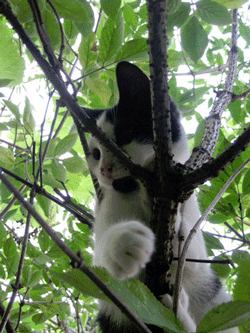By Lisa J. Lehr
This sarcastic question is usually intended to “prove” that cats never get stuck in trees. When they feel like coming down, they will, goes this misguided thinking. The premise of the lame joke, however, is utter nonsense. Cats do get stuck in trees. They do die. Here’s why, and what to do if your cat (or a cat you know) ever gets stuck in a tree.
A cat usually climbs a tree for one of two or three reasons: she’s chasing something (like a squirrel), she’s running away from something (like a dog), or perhaps she just wants to see what’s up there. Okay, so Kitty is way-high-up in a tree, the danger (or the fun or the mystery) is gone, and it’s time to come down. Why doesn’t she come down on her own?
A cat’s claws are designed for climbing up. A cat is not a squirrel; squirrels can climb up, down, and sideways, always headfirst, no problem. But a cat must climb with her head up to avoid falling, and once she’s up, the only way down is to back down. (The margay, or tree ocelot, a rare cat found in the rain forests of Mexico, Central America, and South America, is the only cat that can climb down a tree headfirst.)
Once she’s close enough to the ground, she’ll turn around and jump down; the biggest challenge is a tree that has no low branches, like a pine tree. By the time the immediate danger or curiosity has passed, Kitty has used her burst of adrenaline and does not have enough energy left for the time-consuming, frightening task of descent. This is especially true of an indoor cat with little or no climbing experience.
The good news is, cats have been known to survive over a week in a tree and have sustained falls of over a hundred feet without serious injury. The bad news is, a panicked cat will continue to go…up. Worse, a cat may eventually become too weak to climb down, and after a point, even if rescued, may die later of starvation, dehydration, or exposure.
We don’t see cat skeletons in trees because of a well-known law of nature called gravity: Kitty becomes too weak to hold on, lets go, and falls.
What do you do?
If the cat is not too high—a distance you feel confident climbing yourself—wear gloves, long sleeves, and long pants. Take a pillowcase and rope with you. Make the first grab count; if you only succeed in scaring Kitty, she may go higher. Grab her by the scruff of the neck and stuff her into the pillowcase; secure it with the rope and lower it carefully to someone on the ground. Take the bagged kitty indoors before opening the pillowcase.
If you can’t manage the rescue yourself, wait no more than a couple days. That’s about the longest it will take Kitty to decide to come down if she can. Call your cat. If it doesn’t encourage her to come down, it will at least let her know she’s not forgotten. Keep dogs and other unnecessary commotion away. Try tempting her with food.
If your cat does not meow, it means one of two things: she’s too weak to do so (bad) or she doesn’t feel she is in trouble (good). Unfortunately, you can’t tell which it is.
Get help sooner rather than later if:
- It’s a kitten. Kittens do not have the weight or strength to hang on.
- It’s an indoor cat. She’s not used to being exposed, and she has no climbing skills.
- She’s declawed. A declawed cat has virtually no chance of climbing down without help.
- The cat has been up there for more than two days. After this, her chance of getting down on her own declines sharply, especially considering she’s becoming weaker as time passes.
- Wet, cold, or windy weather is forecast.
- An electrical storm is forecast. If you do decide to call someone, he may decline to come, out of concern for his own safety.
- She’s injured or literally stuck—wedged or (worse) impaled.
- The stranded kitty’s plight is causing stress to you or another family member.
- There’s a reasonable fear of attack by wild animals.
- Her meowing is bothering someone. You don’t want a grouchy, cat-hating neighbor to shoot your cat down.
Who’re you gonna call?
Surprise! Not the fire department. Contrary to folk tradition, most fire departments no longer do cat rescues. Understandably, they do not want to commit their resources to animal rescues when a human rescue may be at stake. Sometimes off-duty firefighters do cat rescues on the side.
Your best bet is a professional tree climbing service. Try these resources for a referral: your vet, pet stores, the Humane Society, Animal Control, the Yellow Pages, the local media, the classified ads.
Tree climbers usually charge for their services, naturally; fees vary, and if travel or hazard duty is involved, will tend to be more. Hazard duty situations include night climbs, dead trees, and inclement weather. Remember, the tree climber’s life is valuable, too, and be understanding about the cost.
He might trade some of his fee for a promise of future work (in trees without cats) and/or some free publicity. Hand out his business cards to your neighbors after the rescue. Animal rescues make great human-interest stories, so be sure to alert the media. Always be polite and respectful with tree climbers, whether they come through for your cat or not. We don’t want to discourage these heroes from future cat rescues.
Some animal behaviorists say you can teach a cat how to climb down from a tree. If you decide to explore this option, please find an expert.
The best option, of course, is to keep all your cats indoors. Cats can be taught to explore outdoors for brief periods under human supervision and come in when called. Some cats will walk on a leash. And if you have the resources and the skills, you can build a “cat sanctuary”—a fenced-in outdoor area your cats can access from indoors. Don’t forget that cats can climb, and put a top on it—which keeps out intruders as well.
Lisa J. Lehr is a writer and copywriter as well as animal lover living in Grass Valley. She can help you promote your business with a full range of online and offline marketing pieces. A member of Empire Toastmasters, she’s available to speak to your business or professional group. Visit her website www.justrightcopy.com for more information, opt in for a message series, and receive a free Marketing Guide.
—
Lisa J. Lehr
I write words that make you money–just ask me how.
www.justrightcopy.com
Visit my website and sign up for my fr~ee marketing tips.
New! No~cost Marketing Guide now available at my website.

